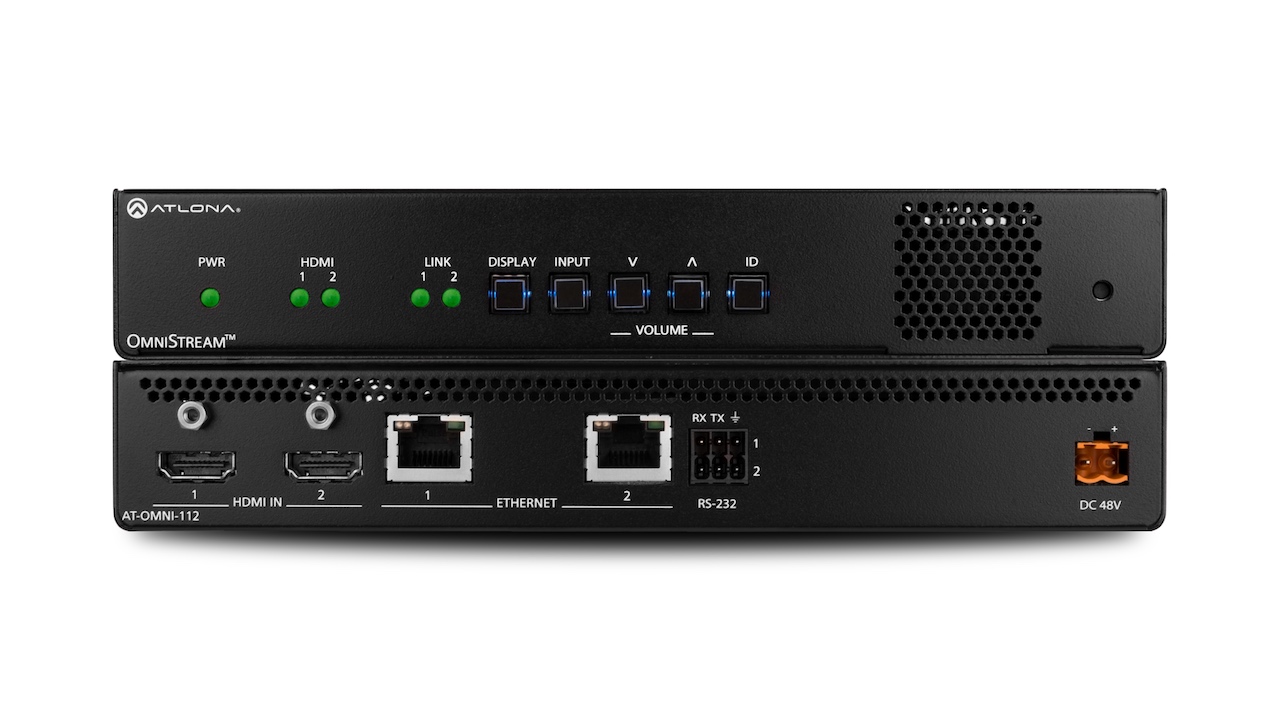Product Review: Atlona OmniStream 112/121 AV over IP Solutions
Jeremy Caldera looks at an Atlona AV over IP solution, testing how the Atlona OmniStream 112 networked AV encoder and 121 decoder transmit high-quality 4K video over gigabit Ethernet infrastructure.

When it comes to AV signal distribution, you won’t find many companies as dedicated as Atlona. When the company launched its OmniStream line in 2017, its goal was to redefine the AV-over-IP category, and included what it claimed to be several industry-first features, such as high-density, dual-channel encoding and decoding, and the ability to convey 4K video and Dante audio simultaneously over the same network.
AV over IP and other trends in 2020
Atlona’s emphasis on IP-based video transport has only been heightened since its 2019 acquisition by network infrastructure company Panduit. The aim of the deal was to create a unified entity that could supply its customers with a one-stop technology foundation, providing everything from networking and electrical cabling to AV control and signal management products.
Related: The Technology Manager's Guide to the State of AV Over IP
Atlona’s ecosystem is united under an enterprise-level solution named Velocity that not only manages end-to-end video and audio switching, but also provides advanced management tools that monitor when rooms are in use and allow users to reserve a space for a meeting. The MDNS auto-discovery makes adding a new device as easy as plugging it in and clicking refresh. Proximity sensors can tell you when attendees begin arriving or when the room is empty again. Even though the system can be set up without Velocity, if you do not already have a room scheduling system, you will want it.
A big part of my job is finding high quality AV solutions, so when given the Atlona OmniStream 112 and 121 to evaluate, I was excited to see how they stacked up against other 4K streaming options that have been installed recently. Plugging in a few items to the test Cisco SG300 switch, I was surprised to see the remote end monitor light up and start displaying content almost as soon as it had been connected. Most surprising was that beyond uploading a config file to the switch, no other configuration or installation was required.
OmniStream Design
For the test, an isolated switch was set up with no DHCP service or internet access. I am sure being able to provide DHCP was probably part of the reason this switch was selected and approved. But I wanted to see the worst-case scenario: what if you are not allowed to run the DHCP server on the client network? (This does happen.)
A daily selection of features, industry news, and analysis for tech managers. Sign up below.
Keeping your converged IP network secure
Typically, with other AV-over-IP devices, the ID button on the front of the decoder will output the IP address of the decoder to the screen; however, with this system, you need to either let everything run a few minutes and fish the MAC table in the switch to find the IP addresses the devices gave themselves, or, in the case of a full Atlona ecosystem, use the MDNS in the company’s Velocity control platform to discover the devices.
The promise of AV over IP for the pro AV market
Software
Devices can be configured individually through their web interface once you have their IP address. However, it is recommended to use Velocity, as it simplifies and streamlines management of all devices. The design of Velocity is intuitive enough to use that I did not need any support documents or additional help. I was able to quickly identify the units I had that needed firmware updates and push them out. After that I was able to easily change video and audio routes between devices.
One drawback to the system is that it requires a virtual machine running Linux and the Velocity host controller. I consider this approach less than ideal; I would have preferred a fully developed Windows solution as some companies I have done business with are resistant to adding Linux into their network.
In addition, because it is a virtual computer, it takes up about 20GB of hard drive space to set up, and can present additional security concerns. These issues, of course, can be mitigated by dedicating and isolating a PC specifically for the job. So, I see it as a niche problem that will not affect most usage.
Summary
Please note that this is not a traditional video switching system; the encoder is running two streams at the same time, and actually four when counting audio. What you get is a flexible, robust, and dynamic system allowing you to send both inputs on the encoder to different locations and break out the audio for each as needed. If you don’t need two inputs, then you can set up redundant streams for increased reliability. The tradeoff to this method is double the backplane bandwidth consumption, as it keeps all streams live.
Testing revealed no problems pulling in a 30Hz 4K signal at 4:2:2. Switching between inputs was instant, and the system having the ability to run a 60Hz 4K 4:4:4 HDR signal is very appealing. Set on the 30Hz mode, the delay between encode and decode is so brief the only way to measure it is by taking a picture of a running stopwatch. The 60Hz mode adds another few milliseconds of latency, but it is unlikely anyone would notice it. This is the best video signal a gigabit switch can carry.
Overall, the OmniStream system is a reliable, high-quality product that will get the job done. Depending on the application, I would definitely recommend this system.
Jeremy Caldera is the CEO and chief design engineer of audiovisual systems at IAS Technology.
Jeremy Caldera, CTS-D, CTS-I is an expert in the professional audiovisual industry with over 25 years of experience. Currently a senior vice president of audiovisual technology at Pearl Technology, a leader in AV and IT services based in Peoria, IL, Caldera specializes in the planning and design of audiovisual systems, organizational management, employee motivation, and the development of corporate standards and business growth strategies. Caldera is also a partner at BNCO Consulting and Top Shelf Digital Media.
Caldera is passionate about sharing his knowledge with others. He worked with his alma mater, Columbia College, to form a partnership with the Audiovisual and Integrated Experience Association (AVIXA) to develop an Audiovisual Systems Integration concentration within the college’s Audio Arts and Acoustics department. This partnership served as a model for what is now a major tenant of the AVIXA Foundation, which provides access to skills education, career pathways, and hands-on experiences to inspire the next generation of leaders in AV.
Caldera is an active volunteer both within the pro AV industry and his community. He previously served as the chair of AVIXA’s Certified Technology Specialist (CTS) Certification Program where he oversaw the development and administration of CTS, CTS-D, and CTS-I certifications. From 2017 to 2019, Caldera was a member of AVIXA’s Leadership Search Committee which appoints and develops mentors to serve on the AVIXA Board of Directors. He also is the chair of the committee for the renewal of the AVIXA/ANSI 2M standard. He currently serves on the board of directors for the Junior Achievement of Central Illinois and the Morton Premier Soccer Club.
Caldera holds a B.A. in Audio Arts and Acoustics from Columbia College, and has won several industry and community awards and honors, including: Systems Contractor News Hall of Fame (2021); iBi’s Peoria Top 40 Leaders under 40 (2017), the NSCA’s Randy Vaughan Founders Award (2017), AVIXA’s Educator of the Year (2017), Commercial Integrator’s 40 under 40 (2015), and AVIXA’s Young Professional Award (2015).

